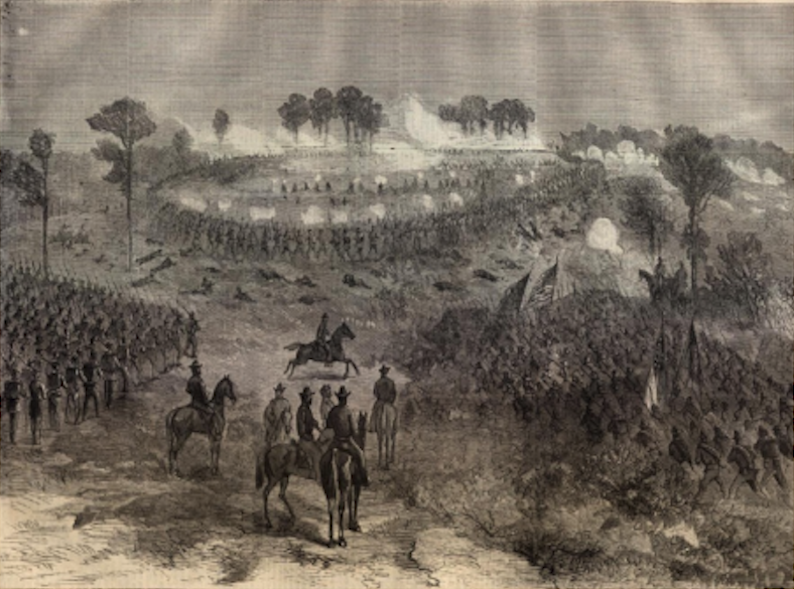National Cemetery Administration
Medal of Honor Recipients: Battle of Chaffin's Farm
The First Recipient Troop: Capturing Confederate Works
The Siege of Petersburg, Virginia, dragged on from spring 1864 into early spring 1865. Confederate troops began building defenses to protect Richmond in 1861. These entrenchments prompted some dramatic fighting, including the disastrous Battle of the Crater, July 1864.
At the end of September 1864, the Union Army made another push to break through Confederate defenses. The goal was to capture Richmond or Petersburg by attacking the anchor of the Confederate works at Chaffin's Farm. The ferocity of this fighting resulted in thirty men receiving the Medal of Honor.
 Battle of Chaffin's Farm, 1864 (Harper's Weekly).
Battle of Chaffin's Farm, 1864 (Harper's Weekly).Surprising Confederate Forces
On September 29, Union troops attempted to draw General Robert E. Lee north of the James River. Previous attempts that summer had failed, so Major General Benjamin Butler decided to surprise the Confederates by attacking from a new direction. Part of Butler's army was to take New Market Heights and Fort Harrison, while another attacked Forts Gilmer, Gregg, and Johnson. The attack stretched from the bank of the James River north to New Market Road.
As part of Butler's army moved north to attack Fort Harrison, he sent a brigade of U.S. Colored Troops (USCT) to attack the high ground called New Market Heights. Temporarily repulsed, the men took the hill with the help of reinforcements, but they suffered heavy casualties. Butler's forces took Fort Harrison.
Advancing the Attack
Following this success, Butler led his army along New Market Road toward Fort Gilmer. Swampy terrain and Confederate defenses slowed the advance, and movement was difficult. Union commanders ordered the USCT, armed with fixed bayonets, to advance. Progress was slow. Unable to advance or retreat, the valiant soldiers ultimately failed to obtain their objective.
Reinforced by Confederate troops retreating from captured forts Gregg, Gilmer, Harrison, and Johnson repulsed the Union assault. The Confederate troops from Virginia, Georgia, and Texas fought hard and inflicted many casualties.
Casualties at Chaffin's Farm
Northern newspapers touted the Union's win at Chaffin's Farm as "highly encouraging," but they suffered an estimated 3,300 casualties. Although African-Americans represented a small proportion of Union forces in the battle, USCT losses made up 43 percent of the casualties. The 6th U.S. Colored Infantry lost 87 percent of its men.
Chaffin's Farm Medal of Honor Recipients
Sergeant William H. Barnes
Sergeant William H. Barnes, Company C, 38th USCT, who though wounded was still "among the first to enter the enemy's works." The 38th USCT was composed of farmers recruited from St. Mary's County, Maryland. Many of them had escaped from slavery in Virginia, and few were free tenant farmers. Barnes continued serving in the U.S. Amy during the Indian Wars until his death in 1866.
Private Charles Veale and Sergeant Alfred Hilton
Private Charles Veale, Company D, 4th USCT, charged into the heavily fortified Confederate defenses with Sergeant Alfred Hilton. Hilton was part of the color guard carrying the American flag. When the regimental color bearer was wounded, Hilton carried both flags forward. After Hilton was injured, Veale took the regimental colors and Sergeant Major Christian Fleetwood the national colors.
According to Veale's citation, "[He] seized the colors after two color bearers were shot down close to the enemy's works. [He] bore them through the remainder of the battle." Hilton, who died in October as a result of his wounds, received the medal posthumously. His citation read, "When the regimental color bearer fell, this soldier seized the color and carried it forward, together with the national standard, until disabled at the enemy's inner line."
Both would receive the Medal of Honor for bravery.
Veterans of the Battle of Chaffin's Farm at VA National Cemeteries
Seven of the men honored for action in the Battle of Chaffin's Farm are buried in VA National Cemeteries:

















